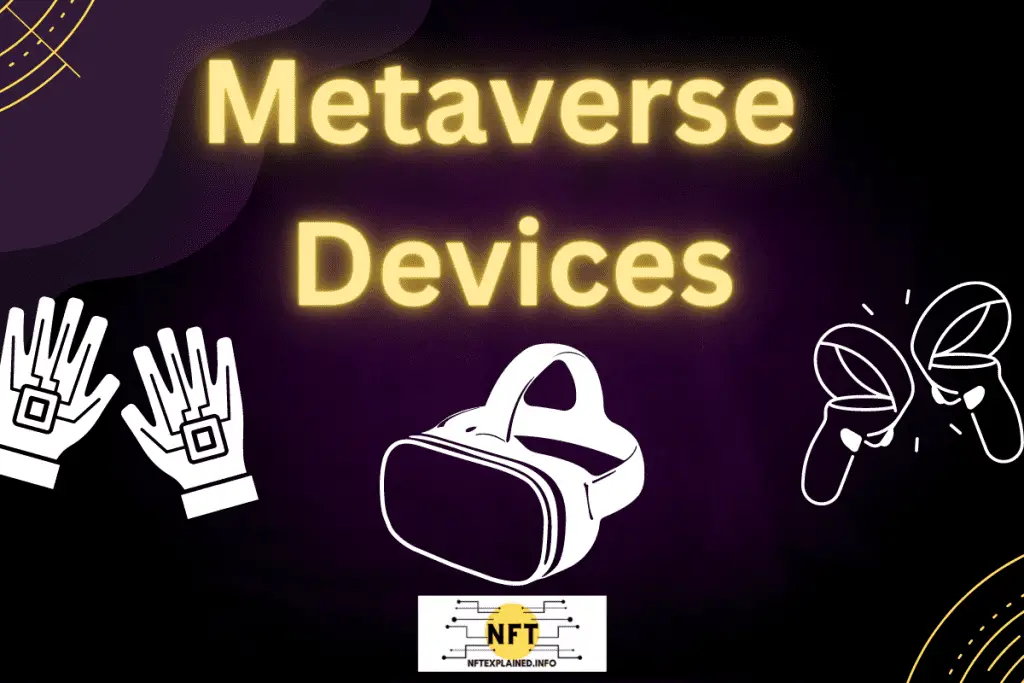
The metaverse is a concept in its infancy yet one that has seen measurable progress with regards to games and technology; the development of metaverse related devices have been expedited by venture capital investments and tech conglomerates (e.g. Meta) investing in this idea.
If you are interested in learning about the core concepts of the metaverse – e.g. interoperability, the ability to monetize through a creator economy (via non-fungible tokens), and some of the abilities users will have in the metaverse – learn here.
One rapidly evolving aspect of the metaverse is the equipment that will be used.
Since the metaverse is still in its infancy, it’s impossible to precisely pinpoint the exact devices needed to access the metaverse and facilitate a fully immersive experience. That being said, it’s widely agreed that metaverse devices will consist of AR, VR, and haptic interfaces.
Haptic devices or haptic interfaces are a form of feedback technology that creates a sense of touch and feel – by linking a person’s ability to feel more immersed within a game or a given virtual 3D environment.
Haptic devices are input and output devices; for example, if a user is wearing haptic gloves, and via the game, the person tries to move a rock, he or she would be able to feel the weight of the rock and other realistic sensations of touching a rock.
Haptic gloves have become increasingly more impressive with some gloves – like the Haptx G1 – using microfluidics to channel compressed air into the gloves (in order to simulate the effects being displayed on screen). The companies developing these gloves have fine tuned the technology so much that raindrops can be emulated.
Widespread adoption of haptic devices is currently restricted by the high cost (e.g. approximately US $4,000 to $5,000 for Haptx glove pre-orders). Until the technology is more affordable, it’s likely that widestream adoption of the metaverse – with the pinnacle of metaverse games including full immersion – is delayed.
Aside from haptic interfaces, virtual and augmented reality devices have been at the forefront of people’s perception of the metaverse. Let’s examine the mass-produced equipment that is available today.
What Are The Top Metaverse Glasses?
For VR headsets, Meta’s Quest2 is an impressive headset that is widely agreed to be the most popular because of its comfortable design and accessibility. For AR, Microsoft’s HoloLens 2 is widely agreed to be at the forefront of enhanced digital interaction in the real world.
Meta’s Quest 2 sits at a more reasonable – yet still somewhat expensive – price of approximately US $400 (for the wireless headset which comes with two controllers); this device allows for a more immersive experience with features like 3D positional audio.
Additionally, Meta’s Quest 2 allows you to dive into Horizon Worlds – which our team has written about in our top 10 metaverse related games article – which can be found here. Aside from Horizon Worlds, other functions like fitness workouts (e.g. boxing) can be enjoyed.
The two controls – which can be comfortably held in your hands – have thumbsticks, buttons, and controllers that enable the ability to partake in other games like Supershot VR (a first person shooter). The controllers are able to track your movements using the same technology as the headset.
For augmented reality, Microsoft’s HoloLens – originally released in 2016 – and contributed to the technological advancement of metaverse devices is widely perceived to be a market leader. More on the history of metaverse related technology, including the history of metaverse games, can be found here.
The successor to the original is Microsoft’s HoloLens 2, which is likely ahead of its time and therefore boasting a price of US $3,500.
Microsoft does brand the device as being mixed reality however our team and many others would argue that it is only an augmented reality device. The device itself contains a holographic aspect that can put virtual items like tables in your home and in a more realistic way (than phones) through its depth tracking abilities.
Through hand tracking, the tool allows you to move around AR objects simply by moving your hands.
This shows the current level of impressive development that tech conglomerates – notably Meta and Microsoft – have been able to deliver. Our team is excited to see the development of haptic devices and other immersive tools like AR and VR (which will help produce the pinnacle of the metaverse).
Let us know which metaverse related device you think has the most potential by connecting with our team on Instagram, Twitter & TikTok! Please subscribe to our YouTube!
Additionally, please consider supporting our team’s content creation through doing business with our partners: Buy a Ledger hardware wallet. Trade stocks & crypto on Webull – get 2 free stocks. U.S. users can get a crypto trading discount on Binance!
